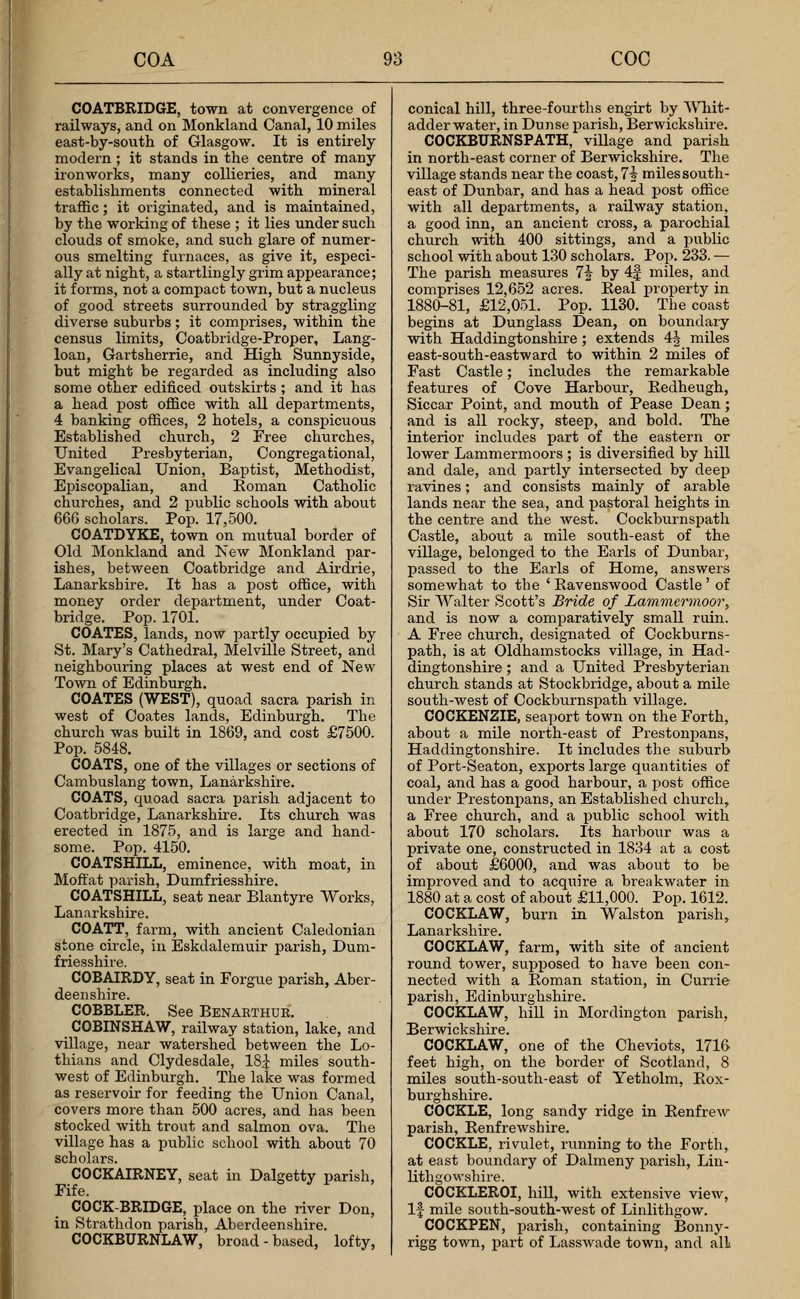COATBRIDGE, town at convergence of railways, and on Monkland Canal, 10 miles east-by-south of Glasgow. It is entirely modern ; it stands in the centre of many ironworks, many collieries, and many establishments connected with mineral traffic ; it originated, and is maintained, by the working of these ; it lies under such clouds of smoke, and such glare of numerous smelting furnaces, as give it, especially at night, a startlingly grim appearance; it forms, not a compact town, but a nucleus of good streets surrounded by straggling diverse suburbs ; it comprises, within the census limits, Coatbridge-Proper, Langloan, Gartsherrie, and High Sunnyside, but might be regarded as including also some other edificed outskirts ; and it has a head post office with all departments, 4 banking offices, 2 hotels, a conspicuous Established church, 2 Free churches, United Presbyterian, Congregational, Evangelical Union, Baptist, Methodist, Episcopalian, and Roman Catholic churches, and 2 public schools with about 66G scholars. Pop. 17,500.
COATDYKE, town on mutual border of Old Monkland and New Monkland parishes, between Coatbridge and Airdrie, Lanarkshire. It has a post office, with money order department, under Coatbridge. Pop. 1701.
COATES, lands, now partly occupied by St. Mary's Cathedral, Melville Street, and neighbouring places at west end of New Town of Edinburgh.
COATES (WEST), quoad sacra parish in west of Coates lands, Edinburgh. The church was built in 1869, and cost 7500. Pop. 5848.
COATS, one of the villages or sections of Cambuslang town, Lanarkshire.
COATS, quoad sacra parish adjacent to Coatbridge, Lanarkshire. Its church was erected in 1875, and is large and hand-some. Pop. 4150.
COATSHILL, eminence, with moat, in Moft'at parish, Dumfriesshire.
COATSHILL, seat near Blantyre Works, Lanarkshire.
COATT, farm, with ancient Caledonian stone circle, in Eskdalemuir parish, Dumfriesshire.
COBAIRDY, seat in Forgue parish, Aberdeenshire.
COBBLER.
COBINSHAW, railway station, lake, and village, near watershed between the Lo-thians and Clydesdale, 18 miles south-west of Edinburgh. The lake was formed as reservoir for feeding the Union Canal, covers more than 500 acres, and has been stocked with trout and salmon ova. The village has a public school with about 70 scholars.
COCKAIRNEY, seat in Dalgetty parish, Fife.
COCK-BRIDGE, place on the river Don, in Strathdon parish, Aberdeenshire.
COCKBURNLAW, broad-based, lofty, conical hill, three-fourths engirt by Whitadder water, in Dunse parish, Berwickshire.
COCKBURNSPATH, village and parish in north-east corner of Berwickshire. The village stands near the coast, 7^ miles south-east of Dunbar, and has a head post office with all departments, a railway station, a good inn, an ancient cross, a parochial church with 400 sittings, and a public school with about 130 scholars. Pop. 233. The parish measures 1\ by 4| miles, and comprises 12,652 acres. Real property in 1880-81, 12,051. Pop. 1130. The coast begins at Dunglass Dean, on boundary with Haddingtonshire ; extends 4^ miles east-south-eastward to within 2 miles of Fast Castle ; includes the remarkable features of Cove Harbour, Redheugh, Siccar Point, and mouth of Pease Dean ; and is all rocky, steep, and bold. The interior includes part of the eastern or lower Lammermoors ; is diversified by hill and dale, and partly intersected by deep ravines ; and consists mainly of arable lands near the sea, and pastoral heights in the centre and the west. Cockburnspath Castle, about a mile south-east of the village, belonged to the Earls of Dunbar, passed to the Earls of Home, answers somewhat to the 'Ravenswood Castle' of Sir Walter Scott's Bride of Lammermoor, and is now a comparatively small ruin. A Free church, designated of Cockburnspath, is at Oldhamstocks village, in Haddingtonshire ; and a United Presbyterian church stands at Stockbridge, about a mile south-west of Cockburnspath village.
COCKENZIE, seaport town on the Forth, about a mile north-east of Prestonpans, Haddingtonshire. It includes the suburb of PortSeaton, exports large quantities of coal, and has a good harbour, a post office under Prestonpans, an Established church, a Free church, and a public school with about 170 scholars. Its harbour was a private one, constructed in 1834 at a cost of about 6000, and was about to be improved and to acquire a breakwater in 1880 at a cost of about 11,000. Pop. 1612.
COCKLAW, burn in Walston parish > Lanarkshire.
COCKLAW, farm, with site of ancient round tower, supposed to have been connected with a Roman station, in Currie parish, Edinburghshire.
COCKLAW, hill in Mordington parish, Berwickshire.
COCKLAW, one of the Cheviots, 1716feet high, on the border of Scotland, 8 miles south-south-east of Yetholm, Roxburghshire.
COCKLE, long sandy ridge in Renfrew parish, Renfrewshire.
COCKLE, rivulet, running to the Forth, at east boundary of Dalmeny parish, Linlithgowshire.
COCKLEROI, hill, with extensive view, If mile south-south-west of Linlithgow.
COCKPEN, parish, containing Bonnyrigg town, part of Lasswade town, and all Hunterfield, Dalhousie, Poltonhall, Hillhead, Prestonholm, SkUtiemuir, Gowkshill, Westmill, and StobhiU-Engine villages, in Edinburghshire. Its length is 3i miles ; its greatest breadth 2J miles ; its area 2950 acres. Real property in 1880-81, 21,071. Pop., quoad civilia, 4544; quoad sacra, 3431. The surface is undulated, but looks to be flat, and consists wholly of fertile land. Coal and good sandstone abound. Dalhousie Castle, a seat of the Earl of Dalhousie, is a chief feature. Cockpen House, the residence of the 'Laird of Cockpen' of Scottish song, stood on a romantic spot near the castle. The parochial church is a handsome edifice of 1820, and contains 625 sittings. Free churches are in Bonnyrigg and Stobhill. There are 4 schools with accommodation for 575 scholars.

